Facet Joint Injection
WHAT IS A SPINAL INJECTION AND WHY PERFORM ONE?
Spinal injections perform 2 purposes: diagnosis and pain relief.
Spinal injections normally consist of two primary components: local anaesthetic and corticosteroid.
Local anaesthetic is used to temporarily numb the region, in order to try to pinpoint the source of the back pain (diagnostic). Corticosteroid is an anti-inflammatory medication used in order to provide more long term pain relief (therapeutic).
Spinal injections can be used to treat pinched nerves or arthritic joints. They are normally performed using X-ray guidance (CT scanner or fluoroscopy). The patient is normally placed face down on the CT or fluoroscopy table. The skin is cleaned with antiseptic and after numbing the skin with local anaesthetic, thin needles are introduced to the facet joints, the perineural or epidural space under x-ray guidance. Guidance with medical imaging confirms safe, accurate placement of the needles and precise delivery of the medication.
WHAT IS FACET JOINT PAIN?
The facet joints are joints in the posterior aspect of the spine that are used when we bend or twist. These joints can undergo degenerative arthritic change and cause mechanical type pain. Often the pain may arise in the neck, mid or lower spine and may radiate to the head, shoulders and buttocks and hips.
HOW IS FACET JOINT PAIN DIAGNOSED?
Your doctor should first take a detailed history and perform a thorough examination.
Degenerative change to facet joints can be demonstrated on spinal x-rays or a CT scan. A CT scan may reveal other causes of back pain and assess other structures in the spinal segment. A bone scan may also help identify and select patients with facet joint pain that may benefit from spinal injections. This type of scan can detect degenerative and inflammatory changes. A bone scan may also be fused with low-dose CT scanning in order to also give more anatomical information.
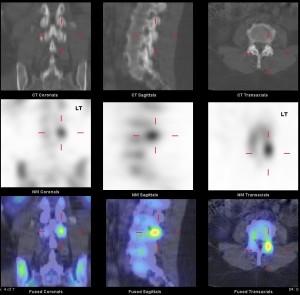
HOW IS FACET JOINT PAIN TREATED?
There are several options for the treatment of facet joint pain. Physiotherapy may improve mobility of the joints and strengthen the surrounding muscles. Medical treatment with analgesics and anti-inflammatory agents are useful for some patients. The surgical option is fusion to stop motion at the painful joint.

Facet joint injection with local anaesthetic and steroid aims to provide therapeutic benefit in order to:
• maintain patient function
• serve as an adjunct when conservative treatment fails
• prevent or delay the need for more invasive surgical intervention.
WHAT IS A HERNIATED DISC?
Intervertebral discs are flexible “shock absorbers” which are situated in between each vertebral body segment. They consist of a central, gel-like portion (nucleus pulposus) and a tougher outer ring (annulus fibrosis). If the outer ring degenerates or there is an acute injury, the central gel may protrude through and “pinch” the adjacent nerve, causing pain, numbness and weakness typically beginning in the neck or back and radiating into the arm or leg. These symptoms are also known as “radicular pain”. When this occurs in the lower back, this also known as “sciatica”.
HOW IS A HERNIATED DISC DIAGNOSED?
Your doctor should first take a detailed history and perform a thorough examination.
Herniated discs and nerve compression is usually diagnosed with cross sectional imaging: a CT or MRI scan.
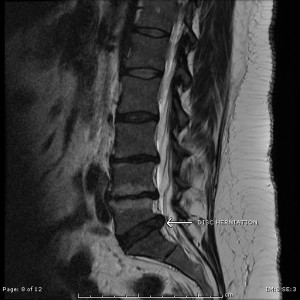
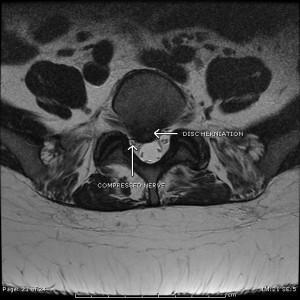
HOW IS A HERNIATED DISC TREATED?
There are several options for the treatment of a herniated disc. Initially, conservative treatments such as rest, anti-inflammatory medication or physiotherapy may be tried.
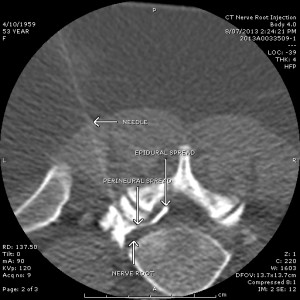
If a trial of conservative therapy fails, an injection of local anaesthetic and steroid around the affected nerve can be of use in order to provide pain relief and to reduce the inflammatory change around the nerve. A thin needle can gain access adjacent to the nerve at the point where it exits the bony spinal canal (perineural or transforaminal injection) or where it exits the spinal fluid sac (epidural injection).
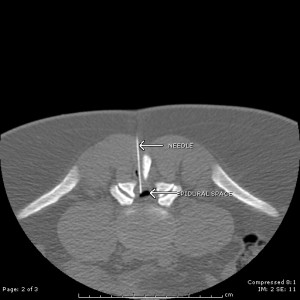
In a small number of patients, surgical treatment is required (microdiscectomy).
Transforaminal and Epidural injections with local anaesthetic and steroid aim to provide therapeutic benefit in order to
• maintain patient function
• serve as an adjunct when conservative treatment fails
• prevent or delay the need for more invasive surgical intervention.
• complement surgical intervention

